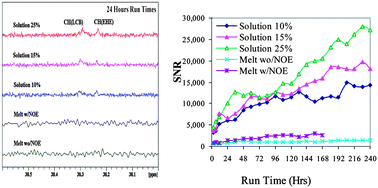At run times of 3 hours to 10 days, with continuous dipolar decoupling, spectral sensitivities at three solution concentrations (with a 10 mm probe) were compared to that of a melt sample (with a 7 mm rotor) of the same polyethylene material. Contrary to all previous findings, solution 13C NMR was found to be superior to the melt technique at all run times. A common mistake in signal-to-noise ratio (SNR) assessment, mixing integral and line height in the same formulation, was corrected. The Observable Sample Weight (OSW) and the extent of nuclear Overhauser enhancement actually achieved were identified as the predominant factors that affected the “signal strength”. “Noise level”, measured using the revised SNR method, was found to be closely related to the width of the peak integral, which increased with increasing solution/melt (liquid) viscosity. The melt technique did not offer any gains in OSW, but there were significant losses in spectral resolution even with the benefits of magic angle spinning and high power dipolar decoupling. All this means that the Solution technique is still the superior 13C NMR technique for quantifying molecular structures of soluble polyethylene (PE) materials.

You have access to this article
 Please wait while we load your content...
Something went wrong. Try again?
Please wait while we load your content...
Something went wrong. Try again?


 Please wait while we load your content...
Please wait while we load your content...